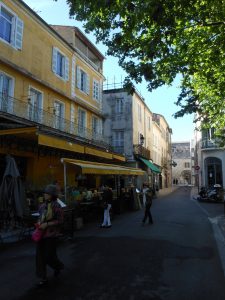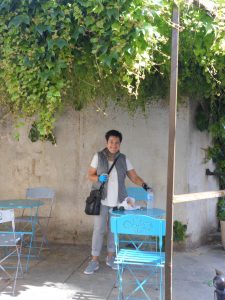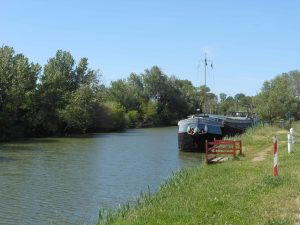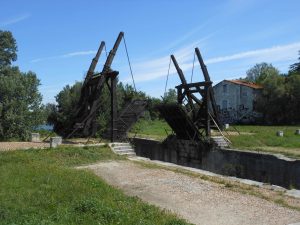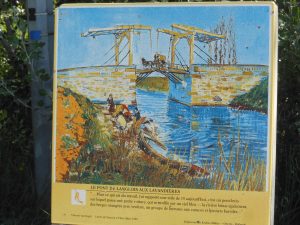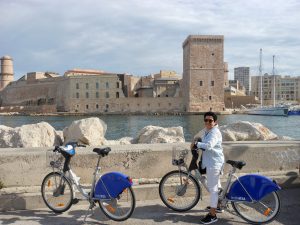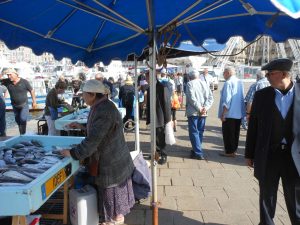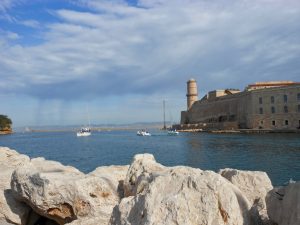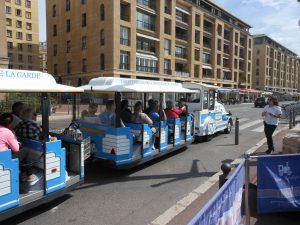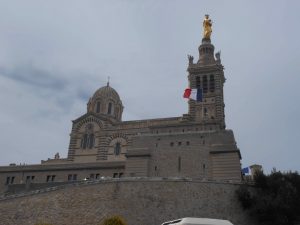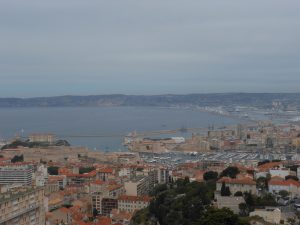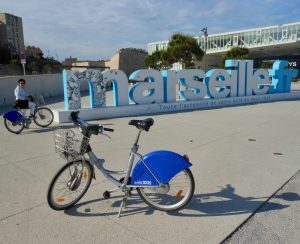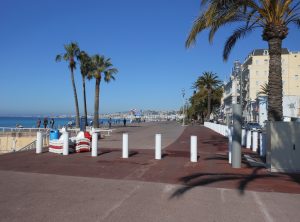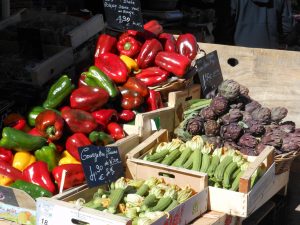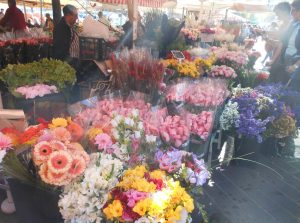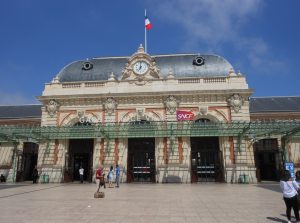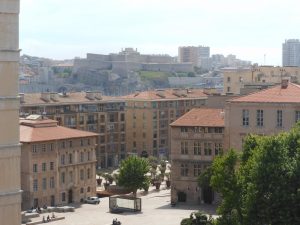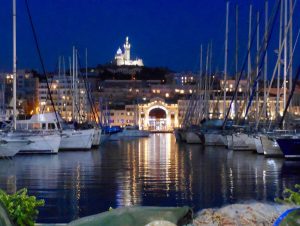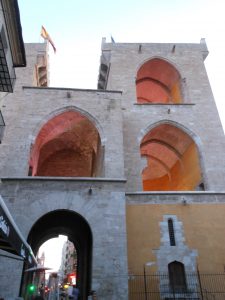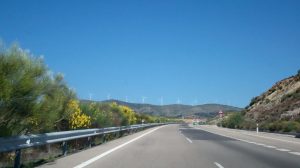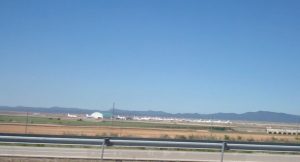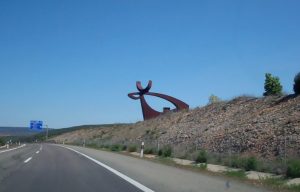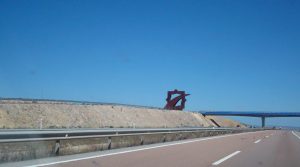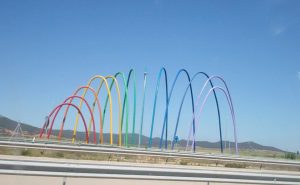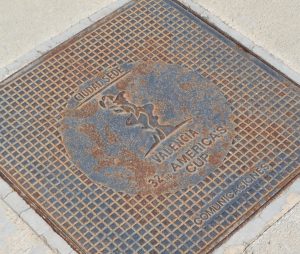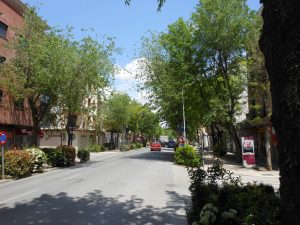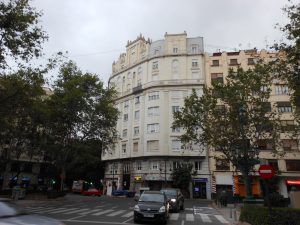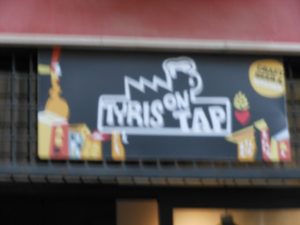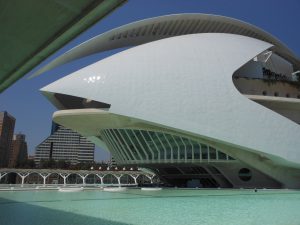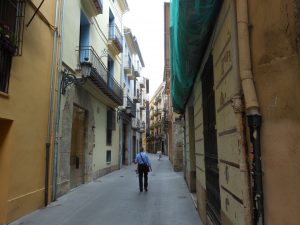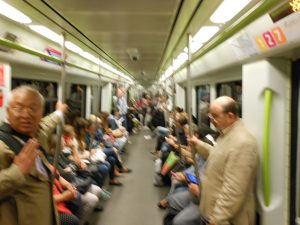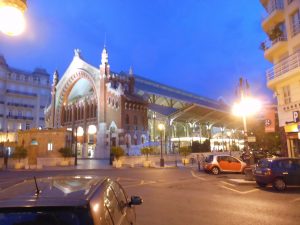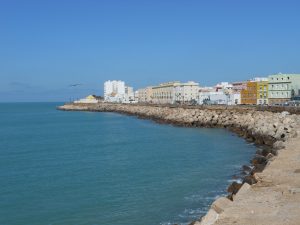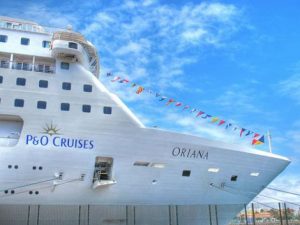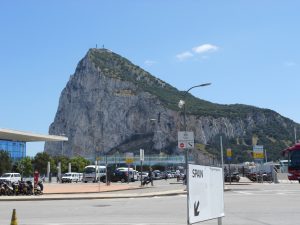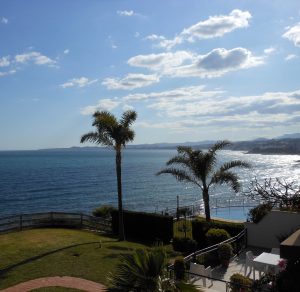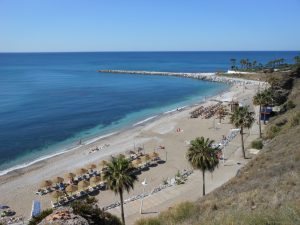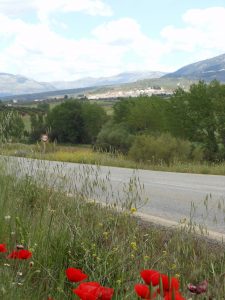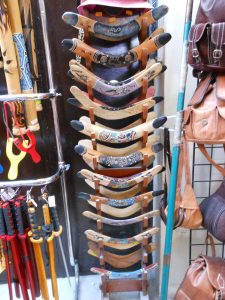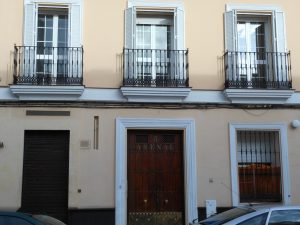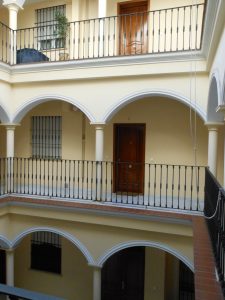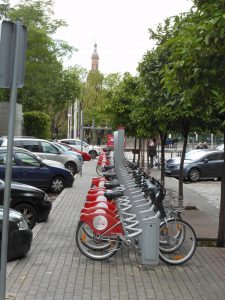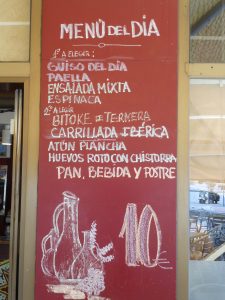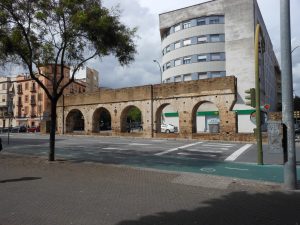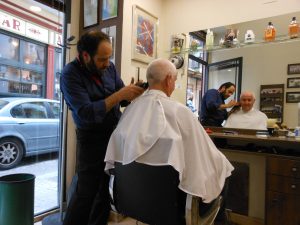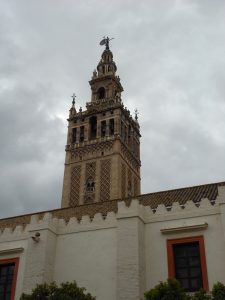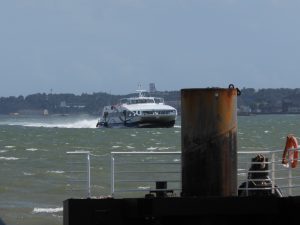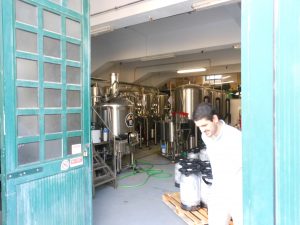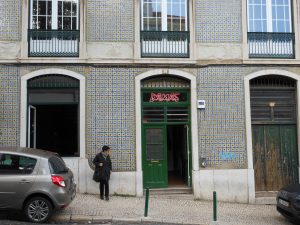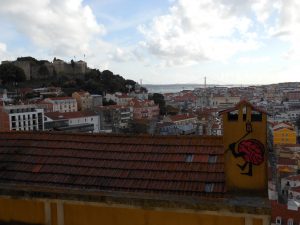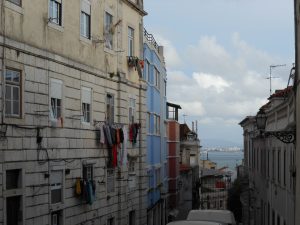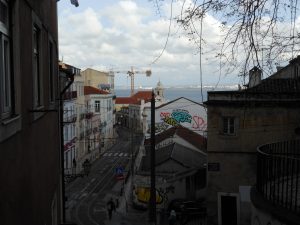Pamplona turns out to be a great city, even when the San Fermin festival is not happening and there are no bulls being run in the street.
The narrow streets of the old town are filled with bars and restaurants and packed with people who clearly have this on their list of Spanish places to visit. After checking into the Tres Reyes Hotel, we walk the short distance to the old town and stop along the way for a street band and a couple of drinks before tracing part of the route of the ‘Running of the Bulls’ and seeing the Pamplona Bull Ring where the run ends.
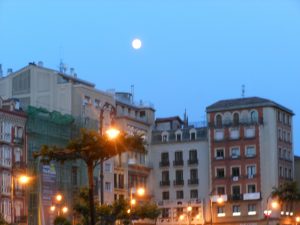 For a relaxed dinner we couldn’t help but choose Cafe Iruna in the main town square; famous as a place frequented by Ernest Hemingway in his fascination for Pamplona and the cultural aspects of the San Fermin festival and the bullfights. The only fight we come close to is with the only waiter we have encountered on the whole trip who oozed attitude. It’s a nice place to sit, however, and we enjoy the passing parade of people and the rising moon above the character filled buildings.
For a relaxed dinner we couldn’t help but choose Cafe Iruna in the main town square; famous as a place frequented by Ernest Hemingway in his fascination for Pamplona and the cultural aspects of the San Fermin festival and the bullfights. The only fight we come close to is with the only waiter we have encountered on the whole trip who oozed attitude. It’s a nice place to sit, however, and we enjoy the passing parade of people and the rising moon above the character filled buildings.
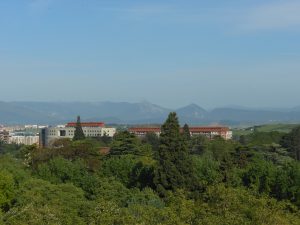 While Pamplona has its core of the old town with all of its traditions, the city itself spreads out to a range of new suburbs and is a green city, framed by the distant mountains. We spend some time the next morning exploring some of the outer areas and find planned suburbs with large blocks of housing arranged around communal open spaces and sporting facilities.
While Pamplona has its core of the old town with all of its traditions, the city itself spreads out to a range of new suburbs and is a green city, framed by the distant mountains. We spend some time the next morning exploring some of the outer areas and find planned suburbs with large blocks of housing arranged around communal open spaces and sporting facilities.
Then, it’s time to head further North to the coast and the beautiful seaside city of San Sebastian, or Donostia, part of the Basque Autonomous Community. Arriving on a Saturday, with large crowds of tourists ambling around narrow streets and across pedestrian crossings proves quite a challenge both for the GPS and driver patience. We eventually locate our AirBnB apartment and Gustavo, our host, jumps into the car to show the way to the underground parking garage where we have a space to go with the apartment which is situated right in the old town itself.
S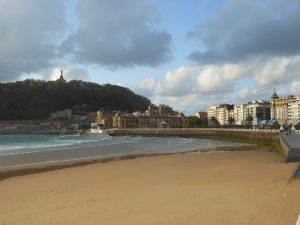 an Sebastian boasts a number of excellent bayfront and seafront beaches; leading onto the Bay of Biscay, and it’s not uncommon to see people in wetsuits walking seemingly incongruously through the streets with a surfboard under their arm.
an Sebastian boasts a number of excellent bayfront and seafront beaches; leading onto the Bay of Biscay, and it’s not uncommon to see people in wetsuits walking seemingly incongruously through the streets with a surfboard under their arm.
Having a few drinks in any one of the huge amount of bars nearby also introduces us to the pintxos, small snack like servings laid out on the bar, often in a huge display and with a large variety.
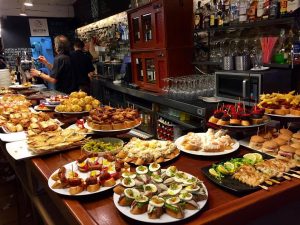 After choosing a drink it’s then possible to choose a number of pintxos and the cost of these is added up and paid when settling the bill. Pintxos can range from 1.5 euros to 3.5 euros and are a delicious way to eat cumulatively. We find that having sampled plenty of pintxos in a few bars that there is no longer a need for dinner and, after finding the only dedicated craft beer bar in San Sebastian we call it a night and look forward to hiring some bikes the next day and having a better look around.
After choosing a drink it’s then possible to choose a number of pintxos and the cost of these is added up and paid when settling the bill. Pintxos can range from 1.5 euros to 3.5 euros and are a delicious way to eat cumulatively. We find that having sampled plenty of pintxos in a few bars that there is no longer a need for dinner and, after finding the only dedicated craft beer bar in San Sebastian we call it a night and look forward to hiring some bikes the next day and having a better look around.
Sunday morning dawns bleak, cold and very wet.
With no chance of getting out and about to see much at all we decide to take the opportunity to head West to Bilbao for the day and visit the Guggenheim museum. It’s an hour or so drive to get there and the route takes us along a number of toll roads, or auto pistes, all of which charge a reasonably hefty toll of up to about 11 euros, or around $16 AUD.
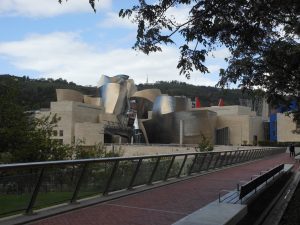 The roads are superb though and we find an underground carpark around 100 metres or so from the Guggenheim and take the time to see the sheer size and spectacle of the beautiful building and the surroundings. This not the first time that we notice that one way these cities deal with the parking issue is to create underground carparks and then create open spaces in the form of plazas or green space at ground level above them.
The roads are superb though and we find an underground carpark around 100 metres or so from the Guggenheim and take the time to see the sheer size and spectacle of the beautiful building and the surroundings. This not the first time that we notice that one way these cities deal with the parking issue is to create underground carparks and then create open spaces in the form of plazas or green space at ground level above them.
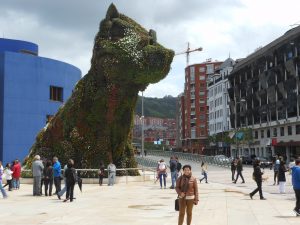 It’s good to have the chance to reacquaint ourselves with the living Westie: a giant puppy created by Jeff Koons with greenery which is blooming. It’s a very worthy addition to the steadily growing collection of #westiesoftheworld.
It’s good to have the chance to reacquaint ourselves with the living Westie: a giant puppy created by Jeff Koons with greenery which is blooming. It’s a very worthy addition to the steadily growing collection of #westiesoftheworld.
We’d bought our entry tickets online so avoided any queues to get into the gallery and spent a number of hours marvelling both at the extent of the work on display and on the scope and scale of the building itself. We were able to interact with a number of the displays and, after taking in as much as we could inside, we were able to brave the icy wind which had sprung up and explore the outside area around the gallery as well.
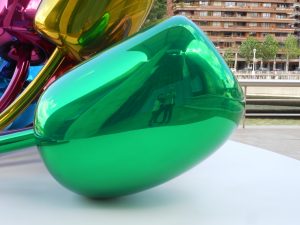 The sheer scale of the magnificent Guggenheim at Bilbao is really impossible to convey on a small video, but there’s a taste in the video below.
The sheer scale of the magnificent Guggenheim at Bilbao is really impossible to convey on a small video, but there’s a taste in the video below.
In an amazing piece of visionary thinking, the Basque government approached the Guggenheim Foundation and offered to build the Museum on former dockland land in Bilbao for $100 million if the Foundation would agree to manage the display and rotate parts of the permanent collection through the spaces. This approach was a key aspect of a revitalisation project for a city undergoing great changes in relevant industry and usage.
The result has seen millions of Euros per year return to the Museum and spin off into a range of other service areas within Bilbao. It just goes to show that courageous investment in bold projects can actually have extremely positive returns for the city or region. Culture and art is not simply a matter of value judged on percentage use by an immediate community but rather in the value it adds to us as humanity. In this case, that value has also led to quantifiable value add in dollar terms which goes way beyond the initial investment. I’m sure that, given the cost of tolls on auto-pistes to get to Bilbao there would have been those who may have suggested that the initial $100 mill be spent on roads or other services. Having been there yesterday with people from around the world, I’m pleased they chose a bolder form of cultural entrepreneurialism.
Guggenheim Bilbao from Roger Pryor on Vimeo.
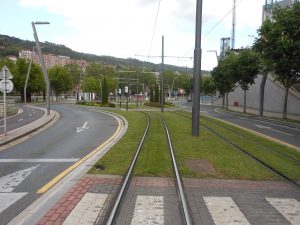 Outside the gallery, the redeveloped dockside area also shows the way the various forms of transport have been arranged to take advantage of the space and provide a cycleway, footpaths, traffic lanes and dedicated light rail, giving an impression of how this can work.
Outside the gallery, the redeveloped dockside area also shows the way the various forms of transport have been arranged to take advantage of the space and provide a cycleway, footpaths, traffic lanes and dedicated light rail, giving an impression of how this can work.
Sunday night, after our trip to Bilbao is spent back in San Sebastian where we walk along the seafront to La Madame, a restaurant which serves up some great food and some very nice locally brewed craft beers. We find that the other two couples eating there are a couple from San Diego and a British couple who usually run a B&B in France. We all end up having a bit of an English language fest and it’s fun to share stories and interesting bits and pieces.
San Sebastian to Leon
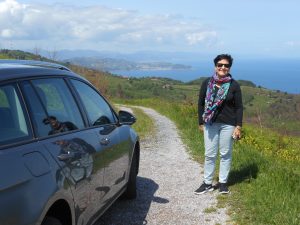 Leaving San Sebastian on Monday morning we find a narrow road which winds Westward toward Bilbao, providing views where each competes to better the last as every corner is turned. Cows and sheep graze in paddocks and green fields slide down the hills toward the green of the sea.
Leaving San Sebastian on Monday morning we find a narrow road which winds Westward toward Bilbao, providing views where each competes to better the last as every corner is turned. Cows and sheep graze in paddocks and green fields slide down the hills toward the green of the sea.
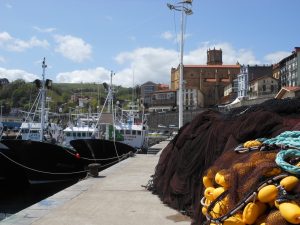 In other places, the road skirts the sea, clinging to the base of the cliffs and opening out to reveal small fishing villages where steep prowed trawlers lie alongside ready to go and challenge the Bay to give up its fish which are hawled onboard from huge nets which lay ready now on the dockside.
In other places, the road skirts the sea, clinging to the base of the cliffs and opening out to reveal small fishing villages where steep prowed trawlers lie alongside ready to go and challenge the Bay to give up its fish which are hawled onboard from huge nets which lay ready now on the dockside.
Eventually we give up the smaller road to make some ground toward our destination for the next overnight stay in Leon and turn again to the auto piste and access to dual carriageways which snake through the mountains, roaring through tunnels and across huge viaducts, with traffic moving steadily along at at least 120kph.
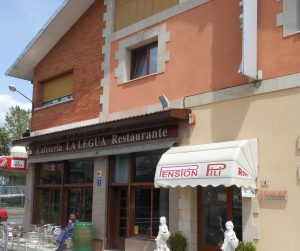 Along the way we take a punt and turn off the auto piste into a small village where we find a restaurant which is clearly popular with locals and travellers alike.
Along the way we take a punt and turn off the auto piste into a small village where we find a restaurant which is clearly popular with locals and travellers alike.
Most of the food is cooked on a grill which sits on a platform above hot wood coals which can be moved up or down to provide an optimum cooking temperature. We’re glad that we’re able to manage enough basic words of Spanish to get through an order where the only menu is what is handwritten in Spanish on the server’s order pad and enjoy a paella with chicken and some grilled fish and beef along with the usual crusty bread and a choice of postres; desserts.
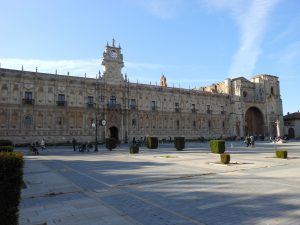 Booking dot com had a daily special for our hotel in Leon for our last night in Spain, the Parador. It’s had a number of roles, including a past as a monastery, and even as a concentration camp during the Spanish Civil War. Michelin rate it at 5 gables. We enjoy the discount rate, and the walk through the city which boasts around 130,000 people. This is a city which has some wonderful buildings and a very substantial ‘feel.’ Despite its housing density at the city core we marvel at the amount of people who have come out after the afternoon siesta to stroll and catch up with others. We see numerous couples, stopping to chat with each other, reminiscent of Saturday mornings in country town main streets many years ago, where community is sustained and enhance by the people who share it.
Booking dot com had a daily special for our hotel in Leon for our last night in Spain, the Parador. It’s had a number of roles, including a past as a monastery, and even as a concentration camp during the Spanish Civil War. Michelin rate it at 5 gables. We enjoy the discount rate, and the walk through the city which boasts around 130,000 people. This is a city which has some wonderful buildings and a very substantial ‘feel.’ Despite its housing density at the city core we marvel at the amount of people who have come out after the afternoon siesta to stroll and catch up with others. We see numerous couples, stopping to chat with each other, reminiscent of Saturday mornings in country town main streets many years ago, where community is sustained and enhance by the people who share it.
Leon is a lovely city and certainly worth a visit. We find an excellent local brewpub, the Four Lions, which has some very good draught craft beer options and then move on to find a large number of restaurants to choose from, where we find some dinner before heading back to the Parador for a great night’s sleep. We’re heading back to Portugal tomorrow.
